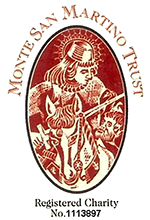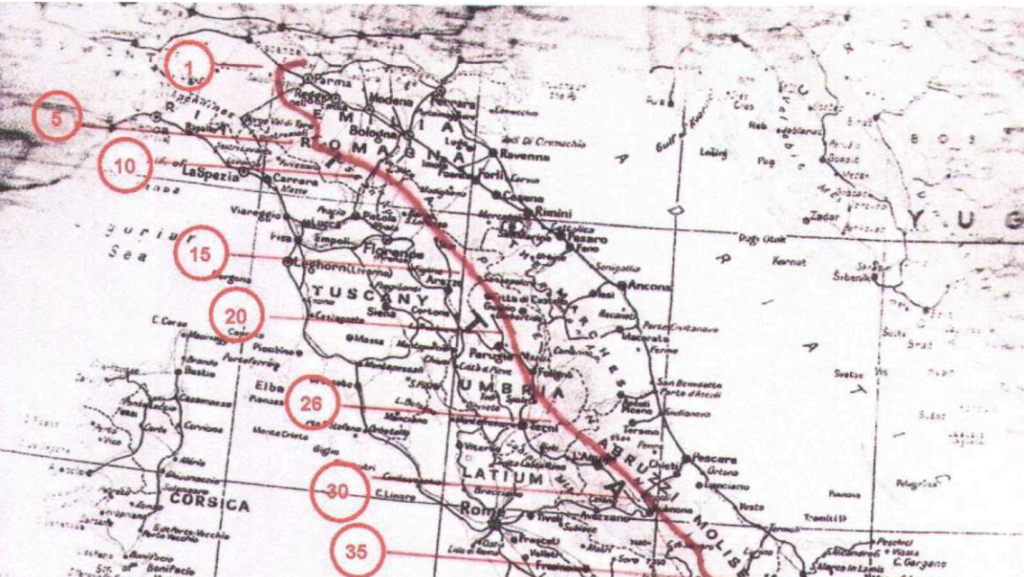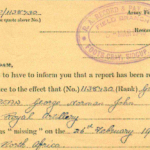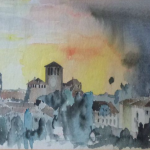Summary
This story comprises the witness statements to the killing of Lionel Herbert John Brown (1909 – 1944) by the Germans, a former POW of PG Campo 70 Monte Urano. It is now believed that the fourth soldier in this group of escapees was a soldier of the Brandenburg Regiment, part of Germany’s Nazi special forces. After questioning by the Germans, the three prisoners, along with an injured parachutist who had been captured at a nearby farm, were taken by motor vehicle to Dragone Bridge near Montedinove, where they are believed to have been shot and killed.
Four bodies were found the next morning under the bridge. Three of the bodies, including that of Lionel Brown, were later exhumed and buried at the Ancona War Cemetery in Ancona, Marche. Note that references to the parachutist appear three different times, in three different ways as Mario Monti), as A Force Agent Mooti , and as Mario Moots.
The full story follows, in two versions. The version in the first window below is the original scanned version of the story. In the second window below is the transcribed version in plain text.
[digital page 1]
[Handwritten note]: Brown, L
[Letter from John Green to Keith Killby]
23rd December 2002
[Handwritten note]: 4 POWs summarily shot by Germans in Val d’Asso in Marche in Montedinove
Dear Keith,
Lionel Brown
You may recall that I have written to you a couple of times regarding Lionel Brown who was a prisoner in Campo 70 Monturano [Monte Urano] and who subsequently escaped and was killed by the Germans. You kindly gave me some clues as to what might have happened to him.
I have now managed to put together a bit more of the story of the time of the escape and subsequent activity. Please find this attached. The MOD [Ministry of Defence] now say that a grave in the Ancona cemetery has been positively identified as being Lionel’s and they are erecting a new headstone.
Thank you so much for the help you gave me. If you have any questions on the attached, please let me know.
Season’s Greetings.
[Handwritten note]: Escape from Monturano [Monte Urano] MARCHE
[Handwritten note]: Excellent research which confirms that 4 POWs were shot without trial on orders of German officers. Betrayed by German in disguise.
[Signature]: John
John Green
[digital page 2]
LIONEL HERBERT JOHN BROWN (1909- l944)
Lionel lived on the run from September 1943 to March 1944. During early March 1944 a series of punitive expeditions took place by the Germans throughout the area where Lionel had been hiding. Posters were exhibited offering a reward for information and forbidding giving assistance to them. He was finally caught at the home of Camillo Carlini, a farmer aged 60 in Montalto. On the 9th March, four men including Lionel had come to the farm to ask for shelter. At 5.a.m. the next morning the Germans had burst into Carlini’s bedroom and demanded to know where the escapees were. The prisoners were then taken to the nearby German HQ which happened to be at a monastery.
At the Public Record Office at Kew there is a file regarding the circumstances of Lionel’s death which was classed as a war crime. The summary at the front of the file reads as follows:
Shortly after 8th March 1943, Lionel known to the family as Giacomo, arrived at the home of Bruno Luzi of Ortezzano. About the end of January 1944, 2 ex-POWs (Daniel Hollingsworth and Thomas White) arrived in the same district at the house of Nazzareno Rossi.
On 14th February 1944 a parachutist dressed in civilian clothes landed in the area of Porchia but owing to the failure of his parachute to open he sustained injuries to his ribs. He was found by a local who took him to the house of the witness where he was cared for. He stated his name was Mario Monti, a Belgian, native of Pergrini [Peregrini] in N. Italy and that he was a member of A force.
On 5th March 1944, Hollingsworth and White visited the house of Luzi and when they left Brown went with them. Luzi did not hear from them for four days. On 9th March they visited the farm of the Veroli family; at this farm was staying a POW – Ernest Chauntry (since repatriated).
The four left the farm together but Chauntry returned to the farm of Veroli and the other three continued to Porchia finally arriving at the house of Vecchiarelli accompanied by another POW they had met on the way and known [to] them only as Adriano. Here they asked for particulars respecting the next expedition through enemy lines but no information was available so they left and went to the farm of Camillo Carlini where Adriano asked for permission to stay for the night. This request was granted and Adriano left the farm stating that he was going to sleep at another farm nearby (later enquiries revealed this to be untrue and there is a little doubt that he was a soldier of the Brandenburg Regiment).
About 5.a.m. the following day (10th March 1944), a party of about thirty German soldiers visited the Carlini farm and arrested the three POWs. The soldiers then immediately went to the house of Viacherelli where they arrested the A force agent Mooti.
[digital page 3]
Arriving in the street it was observed that Adriano was in company with the Germans and that he was not under arrest. The prisoners were then marched to Montano, the German command post where they were questioned by the officers there, Lieutenants Fisher and Rommel and finally placed under guard. About 11 p.m. a motor vehicle containing the prisoners crossed along the Val d’Asso road finally stopping at the Dragone Bridge, 3 miles from Montedinove. A burst of machine gun fire was heard and then the noise of the vehicles starting up and returning along the route they had come. The following morning, 11th March 1944, four bodies were found beneath the bridge.”
After the War, Ernest Chauntry (see above) was interviewed as part of the war crime investigation. Chauntry was in Camp 70 with Lionel and escaped with him. His statement says:
After my escape from the camp on 15th September 1943 I met up with Brown and White. I stayed with them until March 1944 and during that time we made several unsuccessful attempts to cross to the Allied lines. On 11th March 1944 we were making yet another to get through. We left the Montedinove area where we had been hiding and arrived at a house about 6 miles away. We went into the house to try and get some eggs from the owner. We went upstairs and saw that there were about five or six Italians, all men. Brown asked if there were any eggs available and one of the Italians replied that there none to be had as they had no fowls. Brown told me to go downstairs to see if there were any fowls. I did so and left the others upstairs. I went in to the yard and saw that there were fowls there. I went back into the house and saw one of the Italians standing inside the door covering me with a revolver. After about a minute during which neither of us moved one of the Italians upstairs shouted down to the one who was covering me and the latter momentarily turned his head. I immediately struck him, knocked him down and ran outside. I got away across the fields, swam a river and eventually arrived at our starting point”.
There are some additional witness statements that add a few further details:
Bruno Luzi, joiner, Ortezanno
Shortly after the armistice, Giacomo came to stay and remained until 5th March 1944. While he was living with me, Giacomo gave me his particulars. He was tall, thin frame, black hair, dark eyes and widely spaced teeth.
Guiseppe Poletti, gravedigger, aged 42
The bodies were taken to the church at Montedinove and later buried at the cemetery. In September 1944, some British soldiers came to the cemetery and exhumed the bodies. Afterwards the bodies were returned to the graves with a paper bearing their particulars. The soldiers then placed a white wooden cross over each grave.
During the month of November 1944 a British officer and 5 soldiers came to the cemetery and took away three of the bodies – the fourth (Mario Moots) remained in the grave.
[digital page 4]
The MOD [Ministry of Defence] says that the bodies were buried locally but were later exhumed and transferred to the military ceremony at Ancona.
The file says that the key German suspects involved in this war crime were Lieutenants Fisher and Rommel. Rommel was the nephew of the German Field Marshal Rommel. “The suspects were stated to be a German unit stationed in Montalto, the Marcesciallo of Carabinieri named Crimi and also a notorious fascist, Settimio Roscioli. The soldiers belonged to the 3rd Brandenburg Regiment”.
The PRO [Public Records Office] file contains descriptions of the two officers:
Lieutenant Fisher
30-35 years old, about 1.66m tall, broad built with very large shoulders, rather thin face and chestnut hair. On his breast he wore a star and on his right arm he had a swastika over which was an eagle surrounded by a wreath of laurels.
Lieutenant Rommel
About 1.85m, slim build, dressed in black uniform, high boots and black peaked cap.
A third person who was wanted for the crime was Settimio Roscioli, a local fascist who was supposed to have been involved in the betrayal of the escapees. The file mentions that he was later found in the Regina Coeli prison in Rome in July 1945 but does not record what happened to him. He said he could not remember the events at Montalto.
The soldiers used by the officers to enact the execution were “made up of mixed nationalities, including Poles, Romanians and others from the Balkan states”.
The file mentions that the escapees were wearing mainly civilian clothing; this may have classified them as spies in the German mind.
The Rommel connection was noted in a report in The Guardian in May 2002. The MOD [Ministry of Defence] told me that it is probable that this connection probably accounts for the fact that one of the files on the case is still unavailable for public scrutiny.
[Three paragraphs of text in a box]
Search for the suspects
There are two files at the PRO [Public Records Office] which relate to the investigation of the war crime. File WO310:199 is an open file, file WO310:51 was closed until November 2002 but was opened then. I cannot see why the latter file was closed as it covers much the same ground as the former and contains overlapping material. I can only suppose that the photographs of the victims have been thought to be unsuitable for an open file (although similar photographs appear in the open file).
In the files the suspects are named as “Lt. Fischer, Lt. Rommel, Capt Kesting (or Kestring), Adriano, Sgt. Grille and Roscioli”.
[digital page 5]
Fischer was interrogated in July 1945 but he was seriously ill with TB and probably died soon after.
Rommel presented a problem as the name is apparently very common in Wuertemberg where the Lieutenant was supposed to have come from. There are several sightings and interviews recorded on the file but nothing conclusive. Possibly he went to America – there is a report by the U.S. Army that a Lt. Rommel had been sent to the U.S. in May 1944. On the other hand, another Rommel was sighted in Stuttgart in 1946.



